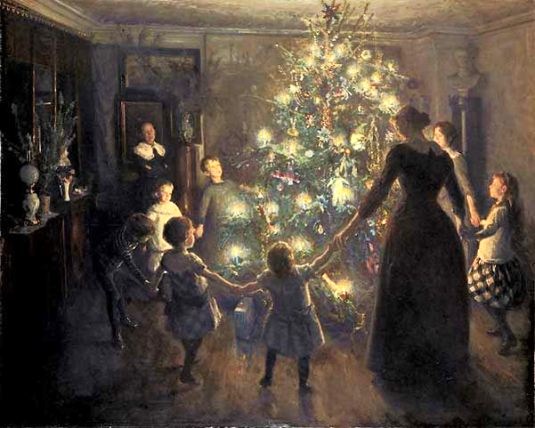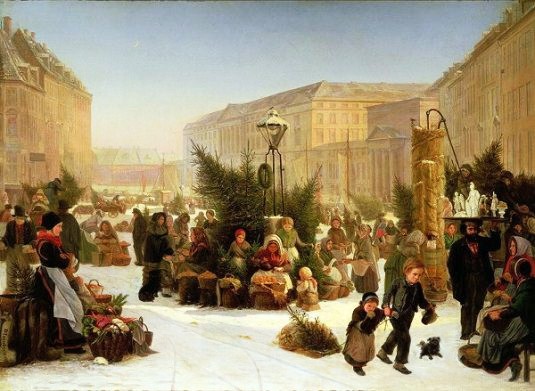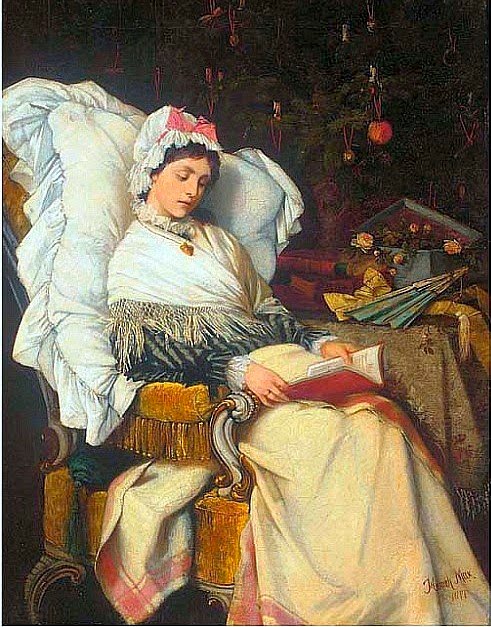19C Mummers. From a MS. in the Bodleian Library
Development of the Christmas Spirit from Pagan Saturnalia to Victorian Feasts.
Written by J.A.R. Pimlott in History Today Volume 3: Issue: 12 1953 See history.com here.
"The English Christmas was largely reshaped in the 19C, but to understand what happened it is necessary to look back to the “old” Christmas out of which it developed. The festivities derived from the pagan midwinter celebrations at the time of the December solstice, which had the promotion of fertility as one of their chief purposes.
"The middle of winter has long been a time of celebration around the world. Centuries before the arrival of the man called Jesus, early Europeans celebrated light and birth in the darkest days of winter. Many peoples rejoiced during the winter solstice, when the worst of the winter was behind them and they could look forward to longer days and extended hours of sunlight.
"In Germany, people honored the pagan god Oden during the mid-winter holiday. Germans were terrified of Oden, as they believed he made nocturnal flights through the sky to observe his people, and then decide who would prosper or perish. Because of his presence, many people chose to stay inside.
"In Scandinavia, the Norse celebrated Yule from December 21, the winter solstice, through January. In recognition of the return of the sun, fathers and sons would bring home large logs, which they would set on fire. The people would feast until the log burned out, which could take as many as 12 days. The Norse believed that each spark from the fire represented a new pig or calf that would be born during the coming year.
"Eating & drinking were always an important feature of midwinter festivals & Christmas observances. The end of December was a perfect time for celebration. At that time of year, most cattle were slaughtered so they would not have to be fed during the winter. For many, it was the only time of year when they had a supply of fresh meat. In addition, most wine and beer made during the year was finally fermented and ready for drinking.
"In Rome, where winters were not as harsh as those in the far north, Saturnalia—a holiday in honor of Saturn, the god of agriculture—was celebrated. Beginning in the week leading up to the winter solstice and continuing for a full month, Saturnalia was a hedonistic time, when food and drink were plentiful and the normal Roman social order was turned upside down. For a month, slaves would become masters. Peasants were in command of the city. Business and schools were closed so that everyone could join in the fun.
"Also around the time of the winter solstice, Romans observed Juvenalia, a feast honoring the children of Rome. In addition, members of the upper classes often celebrated the birthday of Mithra, the god of the unconquerable sun, on December 25. It was believed that Mithra, an infant god, was born of a rock. For some Romans, Mithra's birthday was the most sacred day of the year.
"In the early years of Christianity, Easter was the main holiday; the birth of Jesus was not celebrated. In the fourth century, church officials decided to institute the birth of Jesus as a holiday. Unfortunately, the Bible does not mention date for his birth (a fact Puritans later pointed out in order to deny the legitimacy of the celebration). Although some evidence suggests that his birth may have occurred in the spring,
Pope Julius I chose December 25. It is commonly believed that the church chose this date in an effort to adopt and absorb the traditions of the pagan Saturnalia festival. First called the Feast of the Nativity, the custom spread to Egypt by 432 and to England by the end of the sixth century. By the end of the eighth century, the celebration of Christmas had spread all the way to Scandinavia. Today, in the Greek and Russian orthodox churches, Christmas is celebrated 13 days after the 25th, which is also referred to as the Epiphany or Three Kings Day. This is the day it is believed that the three wise men finally found Jesus in the manger.
"By holding Christmas at the same time as traditional winter solstice festivals, church leaders increased the chances that Christmas would be popularly embraced, but gave up the ability to dictate how it was celebrated. By the Middle Ages, Christianity had, for the most part, replaced pagan religion. On Christmas, believers attended church, then celebrated raucously in a drunken, carnival-like atmosphere similar to today's Mardi Gras. Each year, a beggar or student would be crowned the "lord of misrule" and eager celebrants played the part of his subjects. The poor would go to the houses of the rich and demand their best food and drink. If owners failed to comply, their visitors would most likely terrorize them with mischief. Christmas became the time of year when the upper classes could repay their real or imagined "debt" to society by entertaining less fortunate citizens.
"Little is known about the midwinter observances in Britain upon which Augustine & his successors sought to superimpose the Christian feast of the Nativity. There is a tantalizing reference to the heathen “Yule” in Bede, but for the most part it is necessary to rely on surmise. The story of the English Christmas from the Conversion to the Conquest, however, is epitomized in the instructions which Gregory the Great sent to Augustine. He was to be careful not to alarm the people by interference with heathen ceremonies, & the Pope specifically advised him to allow converts to kill & eat large numbers of oxen to the glory of God at the Christmas festival, as they had formerly done to the Devil.
"Until it had consolidated its position, the Church was obliged to acquiesce in the continuance of many pagan observances; but, as time went on, it was able to effect a synthesis between the old & the new in which the grosser customs had no place. Alfred & other Kings joined with the ecclesiastical authorities in prescribing that the Twelve Days should be kept as a period of festival & abstention from work. Even though the people still performed their traditional dances in the precincts of the church at Christmas, at least they came to church to do so. And a Christian background was provided for the feasting, the telling of tales, the nunstrelsy, the games, the wassailing, & the jousting, with which the Twelve Days were marked.
"The first chapter in the story may conveniently be closed in 1043, when the Anglo-Saxon Chronicle for the first time spoke of December 25th as “Christmas” instead of “midwinter” or “midwinter’s mass.” By the 11C the main elements in the Christmas tradition, which the Normans inherited, had been established. The Twelve Days were the chief period of annual holiday— a sensible recognition of economic realities in a rural society, as well as a compromise with popular tradition. Survivals from paganism had been so successfully blended with Christian observances that even the Church had come to accept the mixture. What principally distinguished this complex of customs from those of today was their communal character; they involved the participation of the whole community, & were focused on some central point, whether it was the church or the hall of the local lord or magnate.
"The Norman Conquest led to no fundamental change in this pattern. One of its consequences, however, was to expose England to Continental Christmas traditions that went back to the Saturnalian & other celebrations of imperial Rome. Though the Continental “Feast of Fools” was never fully transplanted here, among the customs that it contributed to the English Christmas were the “Boy Bishop” ceremonies & the “lords of misrule,” who in the later Middle Ages were common under various names at the Court, in noble houses, & at colleges & inns of court.
"Saturnalian customs never took deep root in England, & the major innovations between the Conquest & the Reformation were largely native in character. The Nativity drama, evolved as a medium of religious instruction, became one of the chief forms of popular art & the forerunner of the secular theatre. But it was the carol that was the main literary glory of the mediaeval English Christmas. Imported in the first place from France & Italy, on English soil it was transformed from a dance song into the medium for some of the loveliest expressions of the English lyrical genius.
"The immediate impact of the Reformation upon Christmas observances was so slight as to be hard to discern... Carols & carol-singing also went into a decline, though this was due rather to the development of instrumental music than to religious reasons. On the surface, things continued much as before, but the changes that were taking place underneath were so fundamental that, when the crisis came under the Commonwealth & Protectorate, it was all the more explosive for having been delayed...
"In the early 17C, a wave of religious reform changed the way Christmas was celebrated in Europe. When Oliver Cromwell and his Puritan forces took over England in 1645, they vowed to rid England of decadence and, as part of their effort, cancelled Christmas. By popular demand, Charles II was restored to the throne and, with him, came the return of the popular holiday.
"The agricultural revolution, the expansion of trade & industry, the growth of the towns, the liquidation of the monastic estates, the increasing differentiation between social classes, all contributed imperceptibly but surely to the disintegration of the “feudal” Christmas of the manor, the gild, & the mediaeval corporation...The author of the late sixteenth-or early 17C verses, The Lamentation of Christmas, deplored the decline of the rural Christmas, attributing it to economic & social causes, which included the exodus of “great men” to London, rural depopulation as a result of sheep-farming, the impoverishment of the farmers, & the high cost of living.
"Herrick’s vivid & delightful descriptions of the countryman’s Christmas are evidence of the vitality of the old customs, even when the Puritan attack was at its height. As for the towns, the old Christmas is nowhere more faithfully summed up than in Ben Jonson’s Christmas Masque (1616), in which the eight sons & two daughters of the central figure, old Gregory Christmas, epitomize the main institutions of the season: “Mis-Rule, Caroll, Minc’d Pie, Gamboll, Post & Paire, New-Yeares-Gift, Mumming, Wassail, Offering, Babie-Cake.”
"Hezekiah Woodward succinctly stated the chief items of the Puritan indictment in the title of the tract he published in 1656: “Christmas Day, the old Heathens' Feasting Day in honour to Saturn their Idol-God, the Papists' Massing Day, the Superstitious Man's Idol Day, the Multitudes' Idle Day, Satan's That Adversary's Working Day, the true Christian Man’s Pasting Day.”
"There were popular uprisings against the Puritan ban, but, as John Evelyn, among others, discovered, the authorities did not hesitate to use the army to enforce it. That the Puritans merely accelerated an historical process is shown by the failure of Christmas to regain its former popularity after the Restoration. But...As Addison, Southey, Cowper & other writers bear witness, the traditional celebrations never entirely died out in rural England. Gay, Leigh Hunt, Charles Lamb, are among those who provide evidence of the survival of the old forms in the towns; & the brisk business in Norfolk turkeys, which developed in the 18C, indicates the importance attached by the Londoner to a good Christmas table.
"Christmas was, nevertheless, by general consent in decline. The author of Poor Robin’s Almanack was perhaps indulging in poetic licence when he declared in 1709:
And Christmas scarcely should we know
Did not the almanacks it show.
"But David Garrick summed up the general view in A Christmas Tale (1774) '
Behold a personage well known to fame;
Once lov’d and honour’d—Christmas is my name!
"And Lamb was probably right in 1827; Old Christmas, he said, “cometh not with his wonted gait, he is shrunk 9 inches in the girth, but is yet a lusty fellow.”
"It is not easy to say why the process of decay should have been suddenly arrested in the middle of the 19C. The Christmas of Pickwick Papers, published in 1836-7, seems to be separated by an age from the Christmas of the Christmas Carol, published in 1843. Pickwick stressed the material side of the festivities, & looked back to the 18C. The Carol looked forward, & was largely responsible for the fact that Dickens, more than any other person, is associated with the modern conception of Christmas. Without neglecting the good things of the season the Carol dwelt upon the spiritual, though not specifically the religious, aspects of the festivity. As the immediate success of the Carol on both sides of the Atlantic showed, Dickens’s role was to translate into literary form the feelings that many inarticulate people were beginning to share.
"Dickens’s Carol was a protest against the hypocrisy that had made a mockery of conventional Christmas sentiments. Ebenezer Scrooge, at least, had the courage of his convictions; which was more than could be said of most of his fellow countrymen. The theme was not original; it was already part of the Christmas stock-in-trade of humanitarian & radical writers. Punch, for example, preached it year after year. “Christmas is fast approaching,” Punch wrote in 1841, “Let the physical weight of all corporations, all private benefactors of the poor, be distributed in eatables to the indigent & famishing.”
"The resurgence of Christmas did not prevent the continued decline of folk customs that had lost their meaning or were ill-adapted to modern conditions. A radical reshaping took place; Twelfth Night, mumming, wassailing, were some of the customs that were discarded. Many industrial workers, including children, had no other holiday than December 25th; & the giving of presents was transferred from New Year to Christmas Day...There were some revivals, the carol being the most important. It had never died out, but most of the mediaeval carols had been forgotten, & carol-singing had declined into little more than a rural folk survival.
"But the chief interest lies in the new customs that were introduced. There were at least three major innovations: in chronological order, the Christmas tree, the Christmas card, &...Father Christmas as we know him now. The Christmas tree in Germany went back at least to the early 17C; it is recorded at Strasbourg in 1605. But it remained localized in Germany, & largely unknown outside, until the second quarter of the 19C.
"The Christmas card...was a British invention. There was nothing novel, of course, about the exchange of seasonable greetings; it was an old custom. But in the age of the penny post the Christmas card was the obvious practical answer to the problem that became more complicated as Christmas was taken more seriously—how to communicate easily with friends & relatives who could not be greeted in person. Although it was separately invented in the forties by Sir Henry Cole, the Christmas card did not take hold until the late sixties. This delay is the harder to explain since it then acquired an astonishing vogue, which for the next generation almost amounted to a cult...
"Some time in the 3rd quarter of the century the traditional English Father Christmas began to be transformed into an anglicized version of the Dutch-American Santa Claus...He survived into the 19C as a grey-bearded symbol that was still being used in Punch as late as the eighties. He had nothing specifically to do with children, & was not associated with the filling of stockings or the bringing of gifts. These were the attributes of Santa Claus, who had evolved in New York State from the Saint Nicholas of the Dutch colonists, & sprang vividly to life in Clement Clarke Moore’s jeu d’esprit A Visit from Saint Nicholas, perhaps better known as The Night Before Christmas. Moore, who was a professor in an Episcopalian theological college, wrote these verses for his family: & they were published in 1823 without the approval of their author, who was afraid that they might prejudice his reputation as a serious poet. Like the Christmas Carol they happened to be perfectly timed. They struck the popular imagination, &, by clothing the Santa Claus myth in convincing detail, became a major influence in extending its currency throughout the world."
 Viggo Johansen (Danish artist, 1851–1935) Silent Night
Viggo Johansen (Danish artist, 1851–1935) Silent Night Felix Ehrlich (German artist, 1866–1931) Christmas
Felix Ehrlich (German artist, 1866–1931) Christmas David Jacob Jacobson (German painter, 1818–1891) Selling Christmas Trees
David Jacob Jacobson (German painter, 1818–1891) Selling Christmas Trees Hans Stubenrauch (German artist, 1875– 1941) Christmas Time
Hans Stubenrauch (German artist, 1875– 1941) Christmas Time Genrich Manizer (Russian artist, 1847–1925) Christmas Tree Market
Genrich Manizer (Russian artist, 1847–1925) Christmas Tree Market Franz Skarbina (German artist, 1849 –1910) Under the Christmas Tree
Franz Skarbina (German artist, 1849 –1910) Under the Christmas Tree Franz Skarbina (German artist, 1849–1910) Boy from the Berlin Christmas Market
Franz Skarbina (German artist, 1849–1910) Boy from the Berlin Christmas Market.+Feast+of+St+Nicholas+1665.jpg)
+A+traveling+family+of+beggars+is+rewarded+by+poor+peasants+on+Christmas+Eve+1834.jpg)
,+Christmas+Eve.jpg)

+Christmas+Morning+1800s.jpg)
+Hanging+the+Mistletoe+1892.jpg)


+The+Christmas+Tree+1911.jpg)



+Katya+in+Blue+Dress+by+Christmas+Tree+1922.jpg)
++The+Christmas+Hamper+1874.jpg)


,+Christmas+Morning+1844.jpg)
+Children+Anticipating+the+Christmas+Feast+1840.jpg)
+A+Christmas+Dole+1800s.jpg)
,+Under+the+Mistletoe+1865.jpg)
+Distributing+Christmas+Presants+1913.jpg)
+Christmas+1939.jpg)

+Christmas+Morning+Service+1908.jpg)
++Santa+with+Toys+1910-20.jpg)
+Christmas+Spirit+1921.jpg)
+Christmas+1903-04.jpg)
+Christmas+1910.jpg)
+Christmas+Eve+1927.jpg)






























